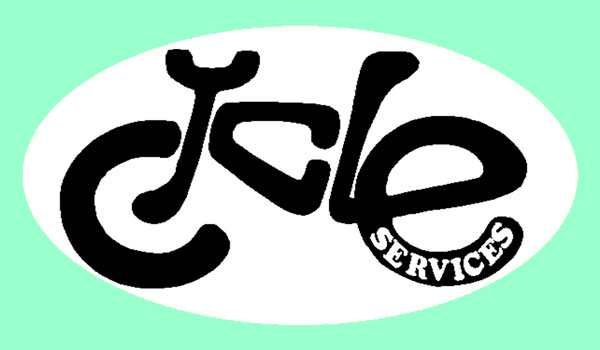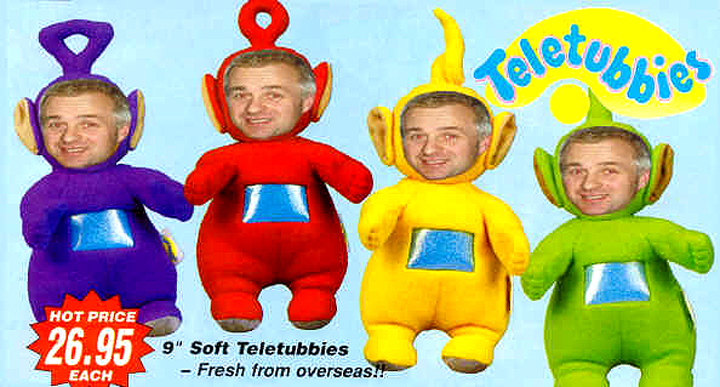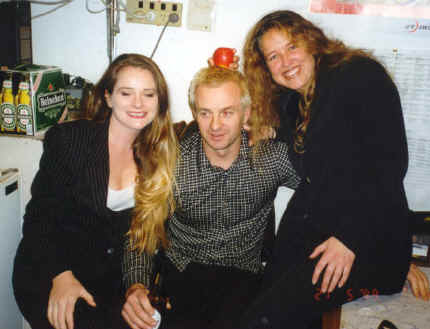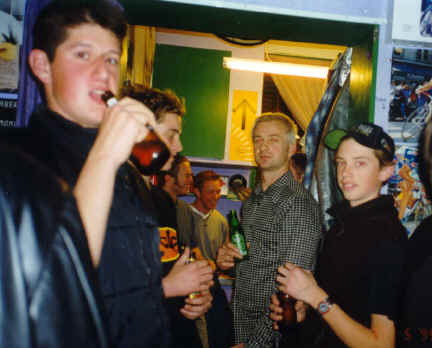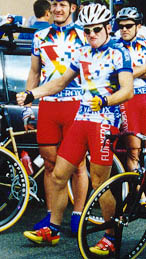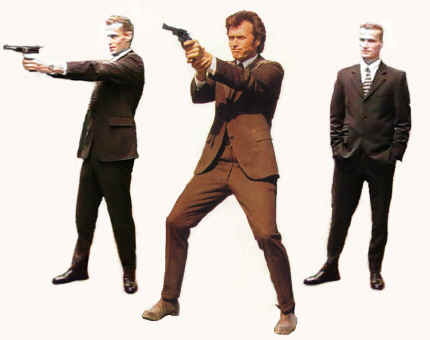SEPTEMBER 1999
Nothing gets me foamed up at the trough like some Hugo Boss suit wearing sifter waltzing into the shop and pulling out a call like, "well son, after going home to consume a substantial portion of roasted meat and listen to some hard uncompromising faceless techno music, I visited your website, and was most disappointed son, most disappointed, to find that it was entirely mainstream, not remotely bizarre, my accountant could have written it". It fully sucks when that happens, makes me feel like I've been pronged up the sphinky by a neutered filchhound, and that's way too close to being a bunch of arse. So for September it's just going to be more chops and less salad, more bush bashing and less keeping to the track. Get a mojo and use it. Yes it's true, Rod is back from overseas - here's a pic to prove it....
Rod's Going Away Party One of the advantages of being really behind, is posting stuff like this. Rod's back now, and here's some pics from his going away party. What a time saver! He gave these enticing young ladies a tray of Red Bull each to pose with him for this photo for his "I am a chick magnet" collection.
Underage Sifters Jon Calder, I hope that's not beer you're drinking there! - What would your mother say to that? Just because Dinsey is a bad arse sifter, doesn't mean you have to follow in his footsteps now does it? Next you'll be letting off fireworks in the street....
Fan mail, hell yeah we dig fan mail, bring it on. Check out this action.
Yeah right, sure thing Norbert, we'll just scoot right along then.....
Tech Tips - 9 Speed Sucks OK it has to be said.... 9 speed is totally inferior to 8 speed. When someone asks me about "upgrading their 8 speed bike to 9 speed" I nearly flip my wig... The only reason it has become so ubiquitous is because manufacturers love to push gimmicks, and punters just seem to lap up whatever hype they get dished out, seemingly having some kind of blind faith that if bike manufacturers are specing it, it must be OK. But it's not. What's wrong with it? - the chain and all the tooth surfaces are too narrow, meaning that the load is concentrated into a tiny area, causing the the teeth to wear like never before. Under hard use 9sp wears at least 50% faster than 8sp, and it costs a lot more for replacement chains and cassettes. (there is no good reason for this cost difference either, it's not like they are higher quality...) A lot of people are unaware that 8 speed is still available, but it is, and the set up I recommend is XT 8sp rapid fire shifter pods, with a SRAM 11-28T or 11-32T 5.0 8sp cassette, a SRAM PC68 chain, an XT 9sp long cage rear derailleur and an XT high mount 9 sp Mega range front derailleur. This set up works better, and is more durable than anything else around. (An XT 11-30T cassette will give even better gear ratios, but costs more than the SRAM ones). Some light riders get away with 9sp, but strong or heavy riders never do. 9sp is an expensive con job. Yes, we sell lots of 9sp chains and chainrings, but my advice to anyone who wants the best gear is: upgrade your 9 speed bike to 8 speed. Just as chromoly frames are better than aluminium, 8 is better than 9.
Two laps of Ngamu Forest in muddy conditions and this 8 speed drive train was messy - but 9 speed wouldn't have lasted the race!
Gearing is an area in which reality has been swamped in a sea of marketing bullshit. All bikes were single speed once, and at the other end of the spectrum it would be quite possible now to make a 560 speed bike (14 speed internal hub with 10 speed cassette and 4 front chainrings). But despite what sales assistants and bike brochures may say, it's no improvement to go from 24 to 27 "gears". In fact., it's a major downgrade. So what is optimum? When MTBs were first mass produced in the mid 80s, road bikes were using 6 speed clusters, with two front chainrings. MTBs added a third chainring and were all 18 speed. What limited them was not the number of gears, but the fact that the screw on (mostly Suntour) clusters were fitted to screw on hubs that were inherently too weak for any serious off road use. The axles would bend and break with monotonous regularity, because the bearings were too inboard to spread the load. The first big advancement in gearing was the use of Shimano cassette style hubs. In the late 80s, the std gear ratios sold were 26/36/46 with a 13-28T 6sp cassette. Most manufactures were fitting a 26T smallest cog, which was bogus, but most people in the know soon swapped to a 24T small chainring. These 18sp setups provided a gear range of 22-108" - a very useful spread of gears. The gear calculation formula is chainring size x wheel size in inches divided by rear cog size. eg. (46T x 26")/12T, or you can look it up on a gear chart. (for road bikes approximate 700C to 27") At this point, the marketing department took over - moving to 21 speed is an impressive sounding upgrade, and it was bound to happen. Even though it required going to wider hubs and frames, along with a narrower chain, I think this upgrade was worthwhile. For durability and cheapness those old 18 speeds couldn't be beaten, but the jumps in gear sizes were slightly too large. Also the new freehub design allowed the use of a 12T cog, giving a decent sized downhill gear. At this point, the 24/36/46 chainrings and 12-30T cassettes were giving spread of 21-110" - note that this range has never been bettered on any subsequent production groupsets - and we are talking 1990 here. At the same time as gear numbers were increasing, there were some other developments happening. "Hyperglide", a system of ramps and reduced tooth sizes to make shifting under power easier, was the best one. Unfortunately, it sacrificed some of the reliability and durability of the drivetrain in order to make it easier to change gear for people who didn't shift smoothly. All modern drivetrains are hyperglide style, and this is one of the reasons they wear out so much quicker than the old 1980's ones. Despite this, I still rate hyperglide as an improvement - it made riding easier and more fun, so that's cool. And Biopace, Shimano's dumbest ever creation, thankfully disappeared for ever more. So by 1991, drivetrains were pretty well sorted. Was this the optimum point? I say not - there was one more thing - with a simple change to the freehub body, it was possible to go to 8 gears on the back, while sticking with the same chain and hub spacing. Nothing was sacrificed. this was the ultimate upgrade, and it could have been the optimum setup from then on - a 24/36/46 crankset with an 11-30T 8 speed cassette (21-115"). There it was - the best setup, back in 1991, and to tell the truth, I have used it on all my own bikes ever since. But did the public get offered it? Hell no! Soon some bozo invented "microdrive" (after 9sp, one of my pet hates) and all of a sudden, those previously excellent 8sp drivetrains were coming with smaller 22/32/42 chainwheels on the front. The top gear dropped to a sorry arsed 100". Where did microdrive spring from? To be honest, I never thought at the time that it would stay, it always seemed like another stupid fad. And it is. But it still exists. I blame "weight weenies" who were a big influence in the early 90s. By the end of the decade weenies were history, but microdrive lives on. My theory is that because very few of the people who were riding offroad in the early 90s are still riding offroad now, people now think microdrive is all there is and accept it as normal. As well as dropping off all the top end gearing, microdrive also wears out quicker, because there are fewer teeth contacting the chain. There's got to be some reason! Ok, here it is. The 32T middle cog supposedly means you can ride uphill without having to change into the "granny gear". Microdrive simply makes the middle chainring an effective second granny gear, so people with a lack of power can delude themselves that they are middle chainring thrashers. Have to blame the bible thumping gimps at Mountain Bike Action Magazine for this ... (although it has to be said that at least they never liked 9 speed) So after settling down for a few years with the 8sp Microdrive setup things were getting boring, and MTB sales were dropping off rapidly. hence 9 speed. By making the cogs and chain narrower (and weaker) it is possible to jam 9 cogs in where there were previously only 8. Sometimes the extra cog is a 32T to give an even lower gear. It's not practical to ride in a 22x32t gear (18") as our legs would whizz round so fast they would fly off. It's actually there so you can stay in that 32t mid chainring and ride up almost every hill. This means that you could take off your 22T cog and dump it (to save weight). Except that then you would only have 18 gears (2x9) and you would be right back where it all started. Sometimes the extra cog is just stuck in the middle, giving closer gear ratios, like a road bike. But closer gear ratios on a MTB just mean more gear changing, because it means that you have to do two gear changes to get a meaningful change in gear ratio. Even if a 9sp offers no real gains, what harm does it do? OK, we sell 9sp cassettes, and it suits us fine if we sell more of them. But I hate selling bogus stuff and I think that marketing scams like this hurt the whole bike industry. I haven't seen any test results, but my own guestimate is that in the best conditions (clean/dry/light or weak rider) 9sp wears out 25% faster than 8sp. But in the worst conditions (dirty/muddy/heavy and strong rider) it can actually wear out over twice as fast (100%+). In fact, I have seen 9sp drivetrains that were technically worn out (chain checker into the red and teeth visibly shark fin shaped) after one ride! And this is XT level componentry.... It's rare to find anyone who thinks that wear rates of 9sp gear is acceptable. But the belief that it is an unavoidable evil is widespread. Not true. 8sp components are readily available so its easy and worthwhile to upgrade a 9sp bike to 8sp, while doing a drivetrain replacement. Here's how: If the bike's drivetrain is worn, you are going to have to replace the chain, cassette and middle (32T) chainring for sure. Replace them with 8sp ones. Freehub bodies are all 8sp and 9sp compatible, so that won't be a problem, as are front and rear derailleurs. The LH shifter is still OK, so only the RH shifter needs to be changed. No difficult choices here - an XT 8sp pod (NZ$125) is the only option. (Yes Shimano do still make them and they are available in NZ) It's probably best to replace the small ring with a stainless steel 8sp one, to avoid chainsuck (and that probably would have been needing replacement anyway), but chances are the existing 42T ring will be OK. So really the only extra cost is the 8sp shifter, but as all the other parts are cheaper in 8sp than 9sp, the total cost is similar. And as the 8sp setup will last between 25% - 100%+ longer, it's pretty economical after 6 months use. Bail out options: Single speed The backlash against marketing driven technology is the single speed - a return to cycling roots. Riding a single speed will mean less repair costs, but that's not the main reason people buy them. In fact, they generally cost a lot more initially than a multispeed bike and it would take a long time to recoup the cost. It's more of an aesthetic choice - the purist response to the corruption of the bicycle by marketing cretins. They work Ok on the flat. but in NZ it's not flat, we have mountains and one gear is far from optimum. I would say it's 23 gears too few. Escaping from 27speed by going back to one speed is a head in the sand approach to technology. Multispeed hubs Some people, especially those with an interest in engineering, feel that the whole derailleur system is an outdated dinosaur, that should be replaced with an internal hub. And it's true that a 14 speed Rollhof hub is a very nice alternative, but are you riding a custom built titanium frame, with the top of the line Marzocchi forks, Hope discs with XTR and Race face components? If not, then the NZ$1500 on a hub could arguably be spent on upgrades that will make more difference to your performance. especially the forks. If the Rollhof system was selling for around NZ$500, the derailleur system could well become outdated. especially if it was possible to change the hub's gear ratios. But as with titanium frames, technology has to provide optimum value for money as well as performance, and no internal hubs do that at this point.
This top of the line Peugeot was 9 speed until it's chain broke sending it flying off a balcony repeatedly...
"BJ" "BJ" from Sportspro knows how to get some air - here he is pulling a no footer. And we thought he just spent all his time modeling Shift gear..
WE WANT HARDCORE BOLLOCK SHREDDING SPEED FRENZY SHIT, NO MUMBLE PANTS. The Wellington Downhill Cup The 1999 Downhill Cup Series will be held over 5 events - Orongaronga, Battle Hill, Makara, Mt Kau Kau, and Wainui Downhill Park.
Cycle Services is sponsoring the Battle Hill Round on 5th December 1999. All races start at 10am, with briefing at 9:30am.
Back to Cycle Services Newsletter Index
|
